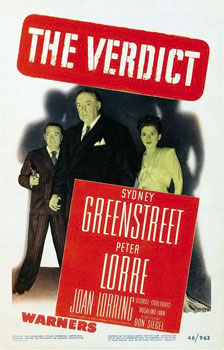Plot
At London's Newgate Prison in 1890, a man convicted of murder is executed. Scotland Yard Superintendent George Grodman had assembled the case against him based on circumstantial evidence. The defendant had claimed that at the time of the murder he was with a Reverend Hoffman, who then immediately departed for Wales, but this alibi witness could not be found there. However, this turns out to be because he actually went to New South Wales. Hoffman returns to London just after the man he would have cleared is executed, and Grodman is fired over the miscarriage of justice. His replacement as superintendent is the obnoxious and gloating John Buckley.
Arthur Kendall, the nephew of the victim in the case, happens to be a friend and neighbor of Grodman, as are artist Victor Emmric and Kendall's political opponent Clive Russell. The three of them visit Grodman together; he tells them he plans to write a memoir of his career, and accepts Emmric's offer to draw the illustrations of bodies and the like. However, Russell and Kendall almost come to blows before leaving.
The next day Kendall's landlady, Mrs. Benson, fails to wake him up, and fetches Grodman from his home to help. Grodman breaks down Kendall's door: the man has been stabbed to death inside the locked room. Buckley starts by consulting a burglar, Barney Cole, about the locks, but Cole cannot figure out how the crime was committed. Then Buckley arrests a music-hall singer, Lottie Rawson, who had been heard arguing with Kendall, but it was only a lovers' quarrel and eventually she is freed.
Russell is the MP from Brockton, and his alibi was that he was traveling there at the time of the murder, but Buckley is able to disprove this and now investigates him. The unused ticket to Brockton is found in Russell's home together with the murder weapon, so Russell is arrested, tried, and convicted.
Awaiting execution, Russell confides a new alibi to Grodman: when he was supposed to be traveling, he was actually having an affair with a married woman. To protect her, he swears Grodman to secrecy, but Grodman traces her anyway. However, this does not help, because it turns out she has just died.
At the last moment Grodman asks Emmric to accompany him to Newgate, where Grodman confesses to the murder. He killed Kendall for justice: Kendall had been the one who murdered his aunt and allowed an Innocent man to be executed for the crime. Grodman faked the locked room by depending on Mrs. Benson's reactions. He drugged Kendall so that he would not wake up in the morning, and when he went to "investigate", Grodman stabbed the sleeping killer while Mrs. Benson was cowering outside the door. He later broke into Russell's home and planted the murder weapon. Thus Russell is exonerated.
Grodman hands Emmric the manuscript of his memoir, which explains all this, and asks him to ensure it is published once the police are through with it. He has now achieved his other purpose in the crime: Superintendent Buckley is humiliated.
